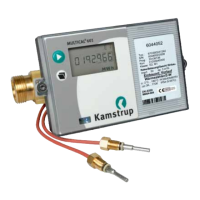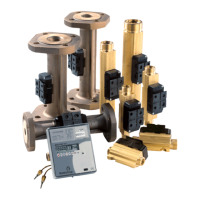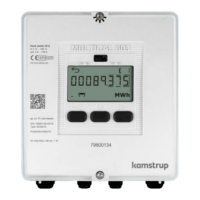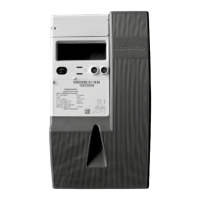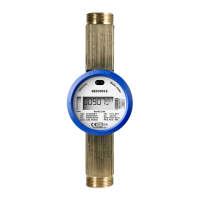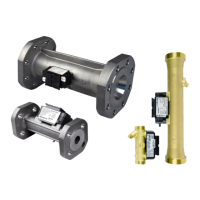MULTICAL®603
KamstrupA/S∙Technicaldescription∙5512‐2029_A1_GB_06.2017
103
7.6 Temperaturemeasurement
InletandoutlettemperaturesaremeasuredbymeansofanaccuratelymatchedPt500orPt100sensorpair.During
eachtemperaturemeasurementMULTICAL
603sendsmeasuringcurrentthrougheachsensor.Thecurrentis
approx.0.5mAforPt500andapprox.2.5mAforPt100.Twomeasurementsarecarriedoutinordertosupp ress
possible50Hz(or60Hz)low‐frequencynoisepickedupviathesensorcables.Furthermore,currentmeasurements
aremade
byinternalreferenceresistorsinordertosecureoptimummeasuringstability.
Thedisplaypresentsinletandoutlettemperaturesaswellastemperaturedifferenceinrange0.00Cto185.00C.
Inletoroutlettemperaturesbelow0Candabove185Careindicatedaslinesinthedisplay,but
serialreading
includes0.00Cand185.00Crespectively.Ifoneorbothtemperaturesensorsareoutsidethemeasuringrange,
theinfocodeissetasshowninthenextparagraph.
Atnegativetemperaturedifference(inletoutlet)thetemperaturedifferenceisdisplayedwithanegativesignand
cooling
energyiscalculated.ItdependsontheselectedDDD‐codewhetherthetemperaturedifferenceisshownin
thedisplay.
Measuringcurrentandpower
Measuringcurrentisonlysentthroughthetemperaturesensorsduringtheshortdurationofthetemperature
measurement.Theeffectivepowerthatisdepositedinthesensorelementsis
thusverysmall,anditsinfluenceon
self‐heatingofthetemperaturesensorsistypicallylessthan1/1000K.
Pt100Pt500
Measuring
current
2.5mA
0.5mA
Peakpower
1.0mW
0.2mW
RMSinfluence
(fastmode)
10W
2W
RMSinfluence
(normalmode)
2W
0.4W
Averagetemperatures
MULTICAL
603continuouslycalculatestheaveragetemperaturesofinletandoutlet(t1andt2)inCwithout
decimals,andbackgroundcalculationsE8,E9,E10andE11arecarriedoutwitheveryvolumecalculation(e.g.with
every0.01m
3
atametersizeofq
p
1.5),whereasthedisplayisupdatedwitheveryintegration(dependingontheL‐
code).Theaveragecalculationsarethusvolumeweightedandcanbeuseddirectlyforcheckingpurposes.
Pre‐programme dtem pera tures
Thetemperaturet3caneitherbemeasuredorpre‐programmedinthecalculator’smemory,whereasthe
temperaturest4
andt5onlycanbepre‐programmed.Seeparagraphs7.1and7.12forexamplesofusingthese
additionaltemperatures.
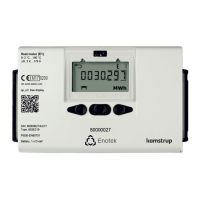
